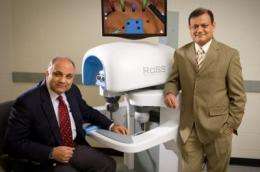Introducing RoSS, a 'flight simulator' for robotic surgery

A collaboration between the Center for Robotic Surgery at Roswell Park Cancer Institute and the University at Buffalo's School of Engineering and Applied Sciences has produced one of the world's first simulators that closely approximates the "touch and feel" of the da Vinci robotic surgical system.
The most widely used system of its kind in the world, the da Vinci robotic surgical system affords all the features that an experienced surgeon needs to ensure equivalent or superior outcomes to conventional surgery.
But such a surgical system, like an aircraft, "is only as good as the pilot, and the current training required for proficiency in robot-assisted surgery is unfortunately less than ideal," said Khurshid A. Guru, MD, director of the Center for Robotic Surgery and attending surgeon in RPCI's Department of Urology. "While surgical practice does make perfect, we believe that through better training tools, the early learning curve of robot-assisted surgery can be shortened without jeopardizing the safety and welfare of patients."
The Robotic Surgical Simulator, or RoSS, addresses the quickly growing need for a realistic training environment for robot-assisted surgery, a field that is rapidly expanding and is expected to constitute a significant number of all surgeries within the next five to seven years. The RoSS will play a critical, educational role for RPCI and other similar institutions involved in robot-assisted surgical systems.
"Think of the RoSS as a flight simulator for surgeons," explained Thenkurussi ("Kesh") Kesavadas, PhD, professor of mechanical and aerospace engineering at UB and head of its Virtual Reality Lab, who, with Guru, invented the RoSS and founded the Western New York-based spin-off company, Simulated Surgical Systems, LLC, to commercialize the simulators.
Creation of the RoSS is an example of how UB and RPCI research can be commercialized and brought to the marketplace to benefit society.
"Until now, surgeons have not had sufficient opportunities outside of the operating room to gain extensive training in robotic techniques," said Guru, whose own surgical expertise has made RPCI's robotics program a Center of Excellence and a world leader in physician training in robotics. Instead, he explains, surgeons usually start by "shadowing" a colleague who is more experienced with robotics in the operating room; once they are seen as having developed some proficiency, they start doing robotic surgeries on their own patients.
Already, at least 70 percent of all prostate surgeries in the U.S. are performed using robotic surgical systems (at RPCI, that percentage is closer to 100 percent both in prostate and bladder surgeries); robotic surgeries are generally less invasive, cause less pain, require shorter hospital stays and allow faster recoveries than conventional surgery. Robotic surgical systems are increasingly being used for gynecologic, gastrointestinal, cardiothoracic, pediatric and other urologic surgeries.
"The RoSS will have a major impact on improving surgical outcomes," said Donald L. Trump, MD, president and chief executive officer of RPCI. "The product's relevance will grow in direct proportion to the acceptance and application of robot-assisted surgery as a best practice around the world. The training that RoSS provides will eventually translate into better quality of life for thousands of patients."
For more than a decade, UB's Virtual Reality Lab has been one of very few in the nation focused on developing haptic technologies -- technologies that bring a sense of touch to virtual reality. "Our experience using computers to transmit accurately the real-time feel and touch of surgery has enabled us to work with Roswell Park to create a training system that provides a highly realistic simulation of robotic surgery," said Kesavadas.
"This is a true collaboration that started between two individuals with world-class skills in their respective areas," said Robert J. Genco, DDS, PhD, vice provost and director of UB's Office of Science, Technology and Economic Outreach (STOR), which assists in the commercialization of technologies developed by UB researchers.
"Hospitals don't invest in these multi-million-dollar robotic surgery systems so that people can train on them," says John Burgess, Simulated Surgical Systems, LLC, chief executive officer. "Their most pressing need has been a good training environment for robotic surgery."
The SUNY Research Foundation and Health Research, Inc., the technology transfer arm of Roswell Park, jointly licensed the RoSS technology to Simulated Surgical Systems, LLC. The company, which employs several engineers who are highly skilled in developing virtual simulation software for surgical applications, plans to begin selling the RoSS by the end of 2010.
More information: A backgrounder on how the work of Kesavadas led to creation of the RoSS simulator is available at http://www.buffalo.edu/news/10997.
Provided by University at Buffalo















